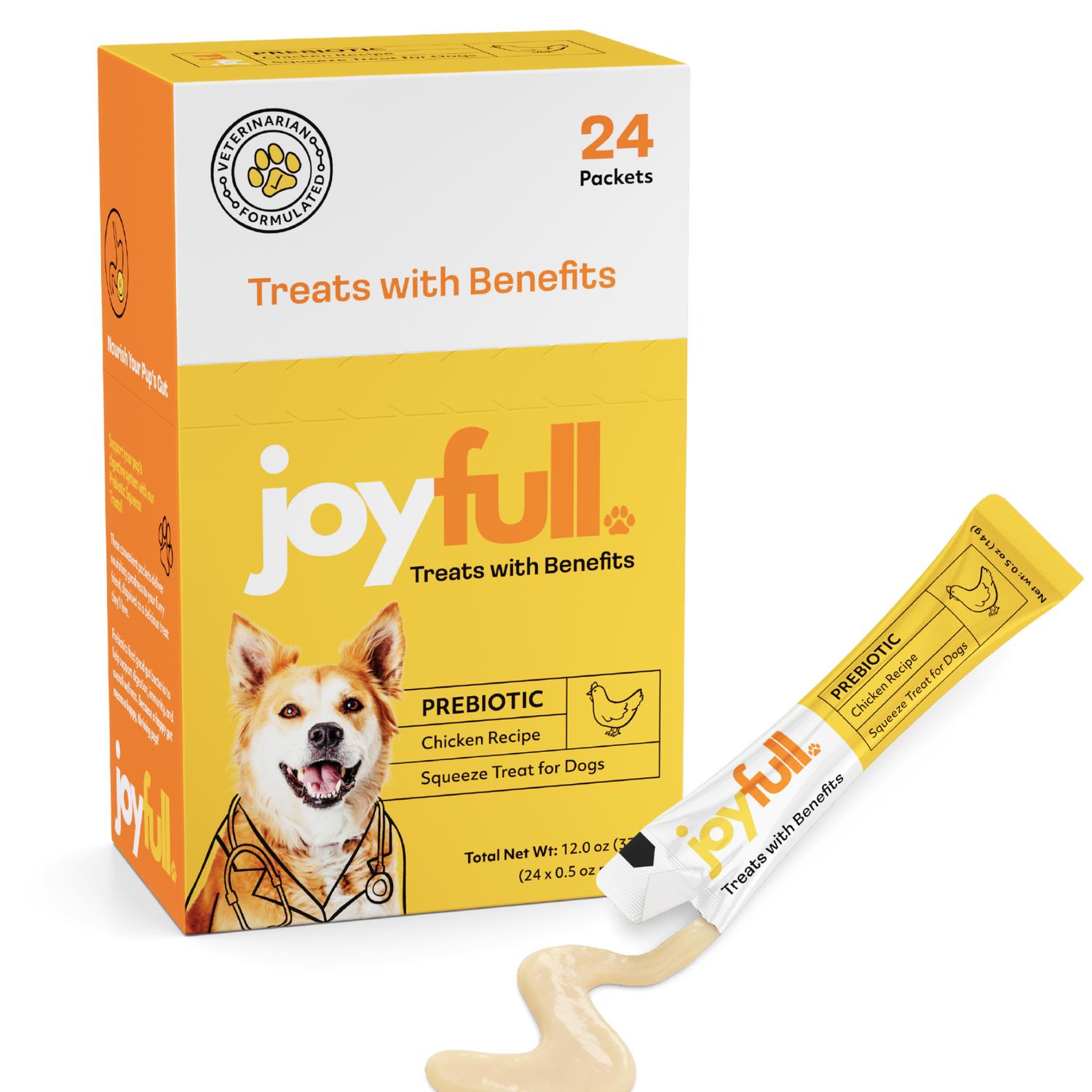
Top Picks: Best Dog Food for Sensitive Stomach in 2024
When you're on the hunt for the right dog food to calm a sensitive stomach, a great starting point is a formula built around a highly digestible, single-source protein. Think lamb, duck, or salmon. These are often found in limited ingredient diets (LIDs), which can be the simplest way to reduce potential irritants and get your dog's digestion back on track.
Is Your Dog's Stomach Trying to Tell You Something?
Ever hear a quiet gurgling sound from your dog across the room? Or maybe your once-enthusiastic eater has suddenly become picky. These aren't just random quirks; they’re often your dog’s way of letting you know something is off with their digestive system.
It helps to think of your dog's gut like a finely-tuned engine. When everything is working perfectly, it runs smoothly and quietly in the background. But if you put in the wrong fuel or the filter gets clogged, that engine will start to sputter and struggle. Your dog might still seem mostly okay, but that underlying discomfort can show up in ways you might not immediately link to their food.
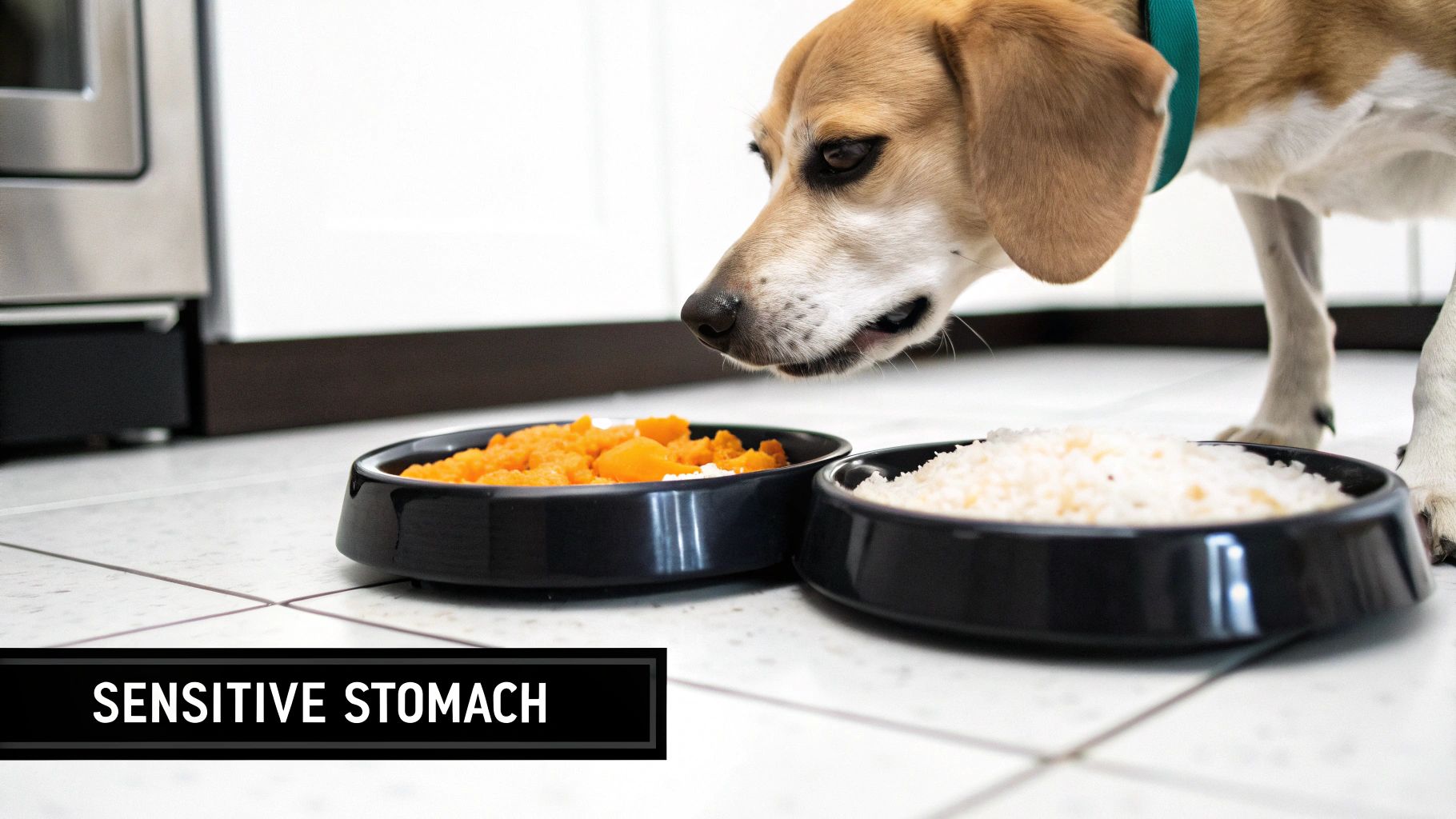
Decoding the Subtle Clues
Digestive trouble isn't always as obvious as vomiting or a bad case of diarrhea. More often, the signs are subtle and easy to brush off. Learning to spot these clues is the first step toward finding a diet that truly helps your dog feel their best.
Keep an eye out for these common, but often overlooked, signs of a sensitive stomach:
- Excessive Gas: Sure, all dogs pass gas. But if it's constant or unusually smelly, it's a red flag for poor digestion.
- Picky Eating: If your chowhound suddenly starts snubbing their meals, it might be because their food is causing discomfort.
- A Dull, Flaky Coat: The condition of a dog's skin and coat is a fantastic window into their internal health. When nutrient absorption is poor, it often shows up on the outside.
- Low Energy Levels: Does your dog seem more lethargic than usual? Their body might be burning extra energy just trying to process food that doesn't agree with them.
When you start seeing these behaviors as communication instead of just "bad habits," everything changes. It puts you in the driver's seat of your dog's health.
By learning to read these signals, you can begin to connect the dots between your dog's diet and their overall well-being. This insight gives you a clear path forward, helping you pinpoint potential problems before they become serious. You're no longer just feeding your dog—you're listening to what their body is telling you it needs.
2. The Common Culprits in Your Dog's Food Bowl
When your dog has a sensitive stomach, their food bowl can feel like a minefield. The first step in finding the right food is to put on your detective hat and learn to spot the usual suspects—the ingredients most likely to cause digestive upset.
Think of it this way: some of us feel awful after eating dairy or gluten, right? It's the same for our dogs. Certain ingredients, while perfectly fine for most pups, can be a real struggle for a sensitive gut to process. It’s not that they are inherently "bad," but they just don't agree with every dog's system.
Unpacking Problematic Proteins and Grains
Believe it or not, some of the most frequent offenders are the proteins we see everywhere. Meats like beef and chicken are fantastic sources of nutrition, but they're also two of the most common triggers for food sensitivities. Over time, some dogs can develop an immune response to these proteins, treating them like invaders. This sparks inflammation in the gut, which is what leads to all that unpleasant gas, diarrhea, or vomiting.
Grains can be another tricky area. Heavier grains like corn, wheat, and soy are often used as inexpensive fillers in commercial dog foods. For a dog with a sensitive system, these can be tough to break down, leading to fermentation in their gut—and all the gassy consequences that come with it. For a deeper dive, you can check out our guide on what causes gas in dogs.
This handy visual breaks down the connection between common allergens and gentler alternatives.
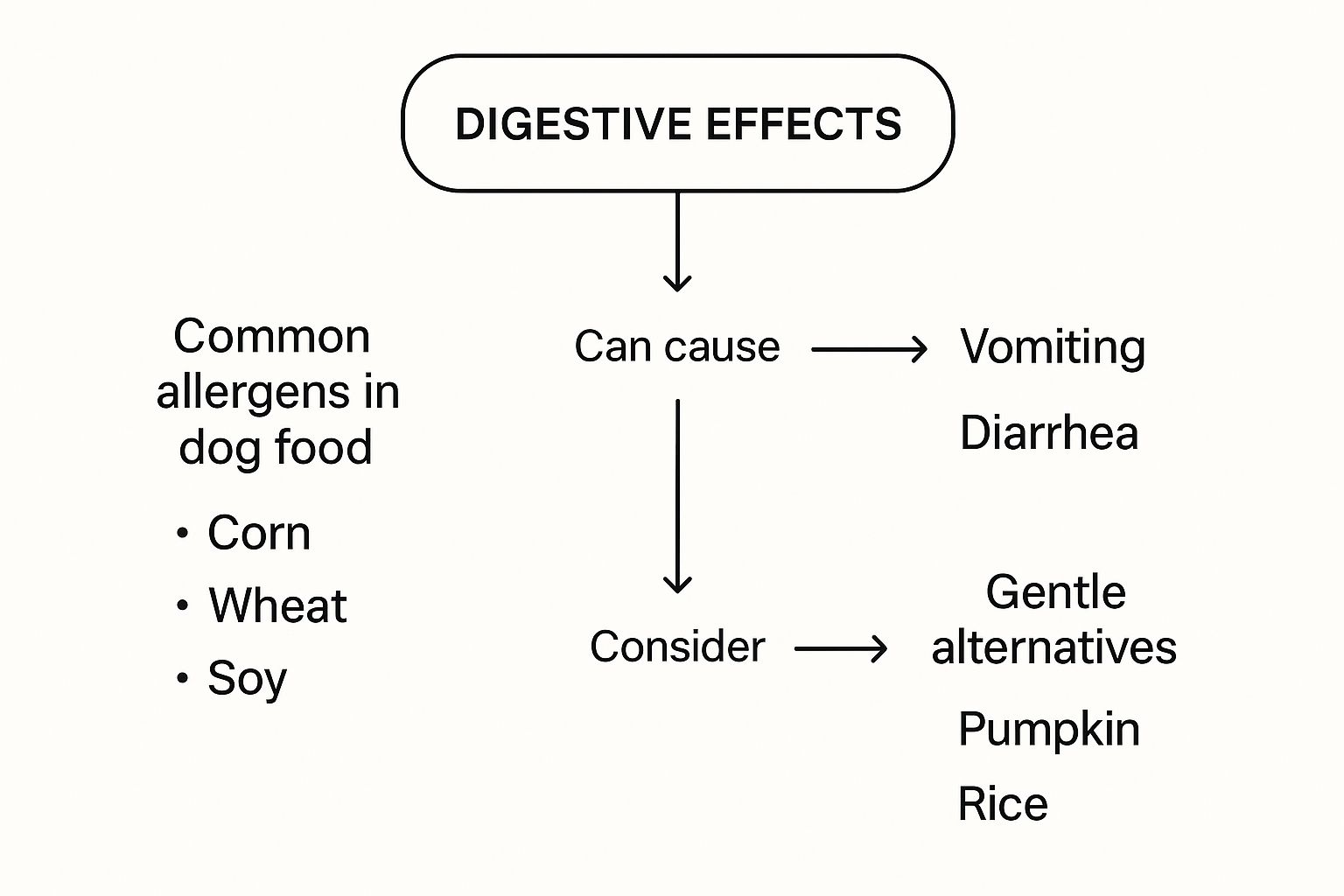
As you can see, swapping out problematic ingredients for soothing options like pumpkin and rice can make a world of difference for a dog's digestive comfort.
To help you quickly identify what to avoid and what to look for, here's a simple comparison table.
Common Problematic Ingredients vs Gut-Friendly Alternatives
| Problematic Ingredient | Potential Issue | Gut-Friendly Alternative |
|---|---|---|
| Beef, Chicken, Dairy | Common allergens that can trigger an immune response and gut inflammation. | Novel proteins like duck, lamb, salmon, or turkey. |
| Corn, Wheat, Soy | Difficult for sensitive dogs to digest; can cause gas and bloating. | Easily digestible carbohydrates like rice, oats, barley, or sweet potatoes. |
| Artificial Colors & Flavors | Offer zero nutritional value and can be chemical irritants for the gut. | Natural flavors from real meat or broth; whole food ingredients for color. |
| Chemical Preservatives (BHA, BHT) | Linked to health concerns and can be harsh on a sensitive digestive system. | Natural preservatives like mixed tocopherols (Vitamin E) or rosemary extract. |
This table isn't about demonizing ingredients—it's about making informed swaps to give your dog's gut a break.
Watching Out for Artificial Additives
Beyond the core ingredients, you also have to watch out for artificial additives. These chemicals are usually thrown in to make the kibble look a certain color or to give it a longer shelf life, but they bring nothing to the table nutritionally. In fact, they can do more harm than good.
Keep an eye out for these on the label:
- Artificial Colors: Things like Red 40, Yellow 5, and Blue 2 are purely cosmetic and can act as irritants.
- Artificial Flavors: Vague terms like "animal digest" or "bacon flavor" can hide a cocktail of chemicals that might upset your dog's stomach.
- Chemical Preservatives: Preservatives like BHA, BHT, and ethoxyquin have been flagged for health concerns and are often too harsh for a sensitive system.
When you learn to spot these potential culprits, that confusing ingredient list suddenly transforms into a clear roadmap. This knowledge is your power—it lets you confidently sidestep foods that might cause a flare-up and choose one that will truly support your dog’s digestive health. In the pet food aisle, you become your dog's best advocate.
How to Choose the Right Food for Your Dog
Walking down the pet food aisle can feel like navigating a maze. Bag after bag screams promises of perfect health, and when you’re dealing with a dog’s sensitive stomach, the sheer number of options is downright overwhelming. But you don't have to just close your eyes and pick one. All you need is a clear strategy for reading the labels.
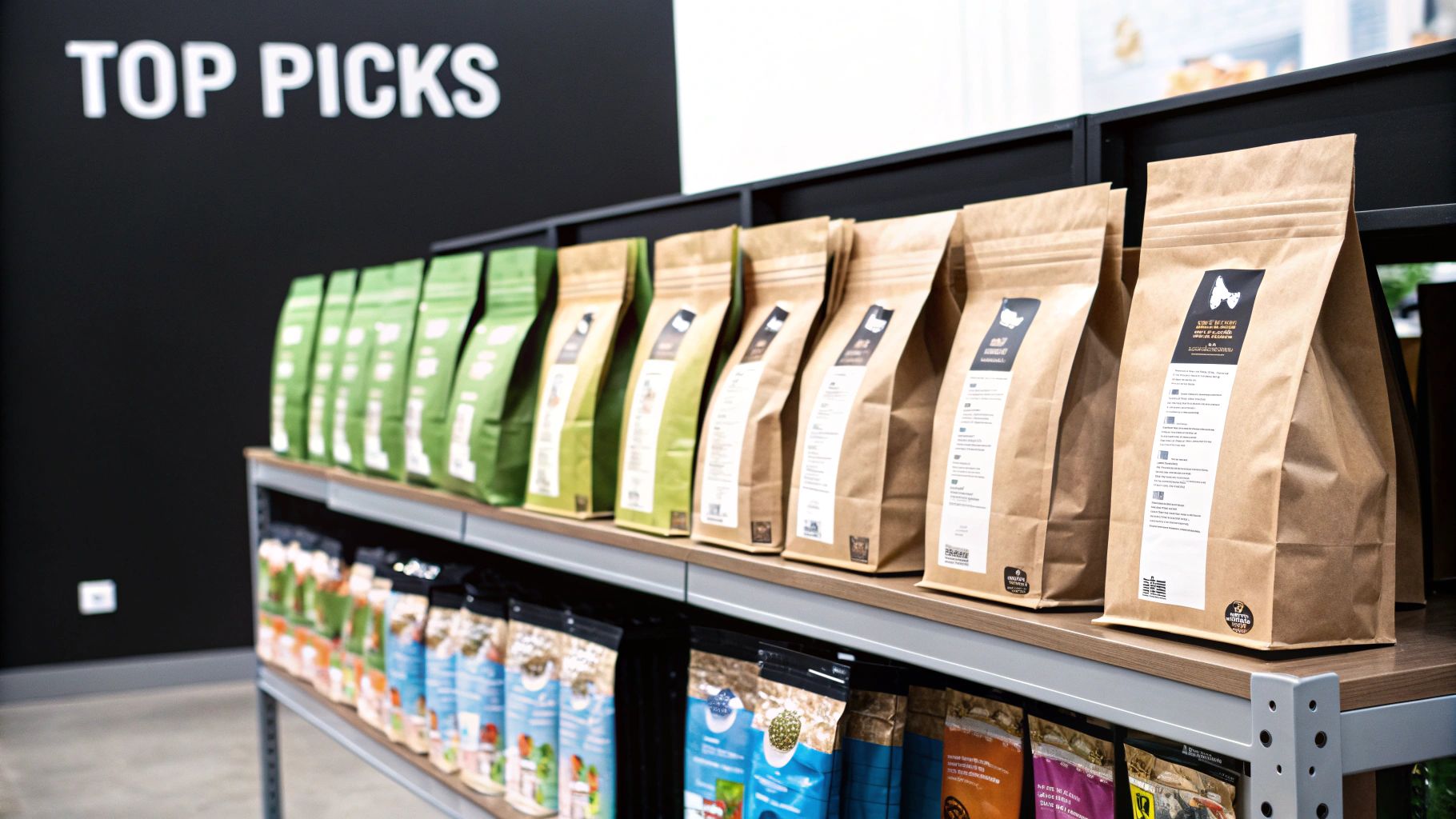
The trick is to flip your thinking. Instead of looking for a food that has everything, your goal is to find one with fewer things that could cause a problem. This is where a little ingredient savvy makes all the difference, turning you from a confused shopper into a confident expert on your dog's needs.
Embrace the Power of Simplicity
For a dog with a finicky gut, the most effective tool in your arsenal is often a Limited Ingredient Diet (LID). It works a lot like an elimination diet a person might try. By dramatically cutting down the number of ingredients, you reduce the chances your dog will eat something that irritates their system.
A true LID zeroes in on a single source of animal protein and just a handful of gentle, easy-to-digest carbohydrates. This minimalist approach makes it so much easier to figure out what agrees with your dog—and what doesn't. You can dive deeper into decoding labels with our guide on what to look for in dog food.
Prioritize Novel Proteins and Gentle Carbs
Often, a dog’s digestive issues come from proteins they’ve been eating their whole life, like chicken or beef. That’s why novel proteins—ones your dog probably hasn't had before—can be such a game-changer.
- Duck: A rich, tasty protein that many sensitive dogs handle beautifully.
- Lamb: This has long been a go-to choice for dogs with sensitive systems because it’s known for being easy on the gut.
- Salmon: Not only is it a great protein, but it’s loaded with omega-3 fatty acids that help fight inflammation.
You’ll want to pair these proteins with carbohydrates that are just as gentle. Forget about heavy grains like corn and wheat, and instead, look for formulas built around:
- Sweet Potatoes: A fantastic source of dietary fiber that helps keep digestion regular.
- Peas: These little powerhouses offer both digestible carbs and protein.
- Oats: A soothing grain that can be very calming for an upset digestive tract.
Look for a Gut-Support Team
The absolute best dog foods for sensitive stomachs don't just avoid irritants; they actively work to heal and support the gut. This is where you'll see ingredients like prebiotics and probiotics on the label.
Think of your dog's gut like a garden. Probiotics are the beneficial seeds (the good bacteria) you're planting. Prebiotics are the fertilizer that helps those good seeds grow strong and healthy. Together, they create a thriving, balanced gut microbiome.
A strong, healthy gut lining is essential for absorbing nutrients properly while blocking irritants from entering the bloodstream. This focus on proactive gut health is what separates a truly premium sensitive-stomach formula from the rest.
This shift isn't just a niche trend. The United States pet food market was projected to hit about $44.2 billion as more and more owners look for foods with functional ingredients like probiotics and omega-3s. It just goes to show you're not alone in wanting better, more targeted nutrition for your four-legged family member.
Comparing Food Types for Digestive Health
When you're trying to soothe a sensitive stomach, it's not just about what's in the food—the form it takes is just as important. Kibble, wet food, fresh meals, and even raw diets all come with their own set of pros and cons. Figuring out which one is right for your dog means looking at their gut health, your lifestyle, and your budget.
There’s no magic bullet here. What works wonders for your neighbor's dog might not sit well with yours. The goal is to find the sweet spot: maximum digestibility with the least amount of irritation for your furry friend.
The Great Debate: Kibble vs. Wet Food
For as long as most of us can remember, dry kibble has been the king of convenience. It’s easy to store, a breeze to serve, and generally kinder to the wallet. But for a dog with a tricky tummy, there can be a downside. The high-heat processing needed to create those crunchy bits can sometimes make certain nutrients harder for their system to absorb. Plus, its low moisture content isn't always ideal for smooth digestion.
On the other side of the aisle, you have wet or canned food, which is packed with moisture—often around 75%. All that extra water is fantastic for digestion and keeping your dog hydrated, which is a big win. The softer texture and rich aroma can also be a lifesaver if you've got a picky eater on your hands. The main trade-off? Wet food usually costs more and you'll need to refrigerate the leftovers.
You can think of it like this: kibble is the efficient, dehydrated meal you'd take on a hike, while wet food is more like a hearty, hydrating stew that tempts even the fussiest eater.
The Rise of Fresh and Raw Diets
There's a reason fresh food diets have become so popular lately. These meals are typically crafted from human-grade ingredients and cooked just enough to preserve nutrients, making them incredibly easy to digest. Since they are so minimally processed, they're often a great match for a sensitive system. The biggest hurdles are the price tag and the need for dedicated fridge or freezer space.
Raw diets take that concept a step further by cutting out the cooking entirely. The idea is to feed dogs a diet that more closely mimics what their ancestors ate. Fans of this approach argue that it offers the highest possible nutritional value. However, it’s not without its risks—improper handling of raw meat can expose both your dog and your family to bacteria like salmonella or E. coli, so meticulous care is a must.
This shift toward less processed foods is more than just a fad. We've seen search interest for freeze-dried and raw dog food, often chosen for their simple, additive-free formulas, hit a relative peak of 156.39. Even though that search buzz later dropped by 26%, sales have continued to climb. It's a clear signal that owners are serious about finding better solutions for their sensitive pets. If you're curious about the market, you can see what's driving pet food innovations.
To help you sort it all out, here's a quick rundown:
- Dry Kibble: Best for convenience and your budget, but can be a tougher digestive challenge for some dogs.
- Wet Food: A great choice for hydration and tempting picky eaters, though it comes at a higher cost.
- Fresh Food: Delivers top-notch digestibility and quality, but you'll need a premium budget and cold storage.
- Raw Food: Offers maximum nutrient density, but it demands strict safety protocols and careful handling.
At the end of the day, picking the right food for a dog with a sensitive stomach is a balancing act. It’s about weighing these factors to discover what truly helps your individual dog thrive.
How to Safely Transition to a New Dog Food
So, you've found what looks like the perfect food for your dog's sensitive stomach. Fantastic! But your job isn't quite done yet. How you introduce that new food is just as important as the ingredients listed on the bag.
Think of it this way: your dog’s gut is a finely-tuned ecosystem, and the bacteria living there have grown accustomed to their current diet. Suddenly swapping their food is like sending a shockwave through that delicate environment, which can cause the very digestive upset you’re trying to solve. A slow, gradual transition gives that gut flora time to adapt, making the switch a success.
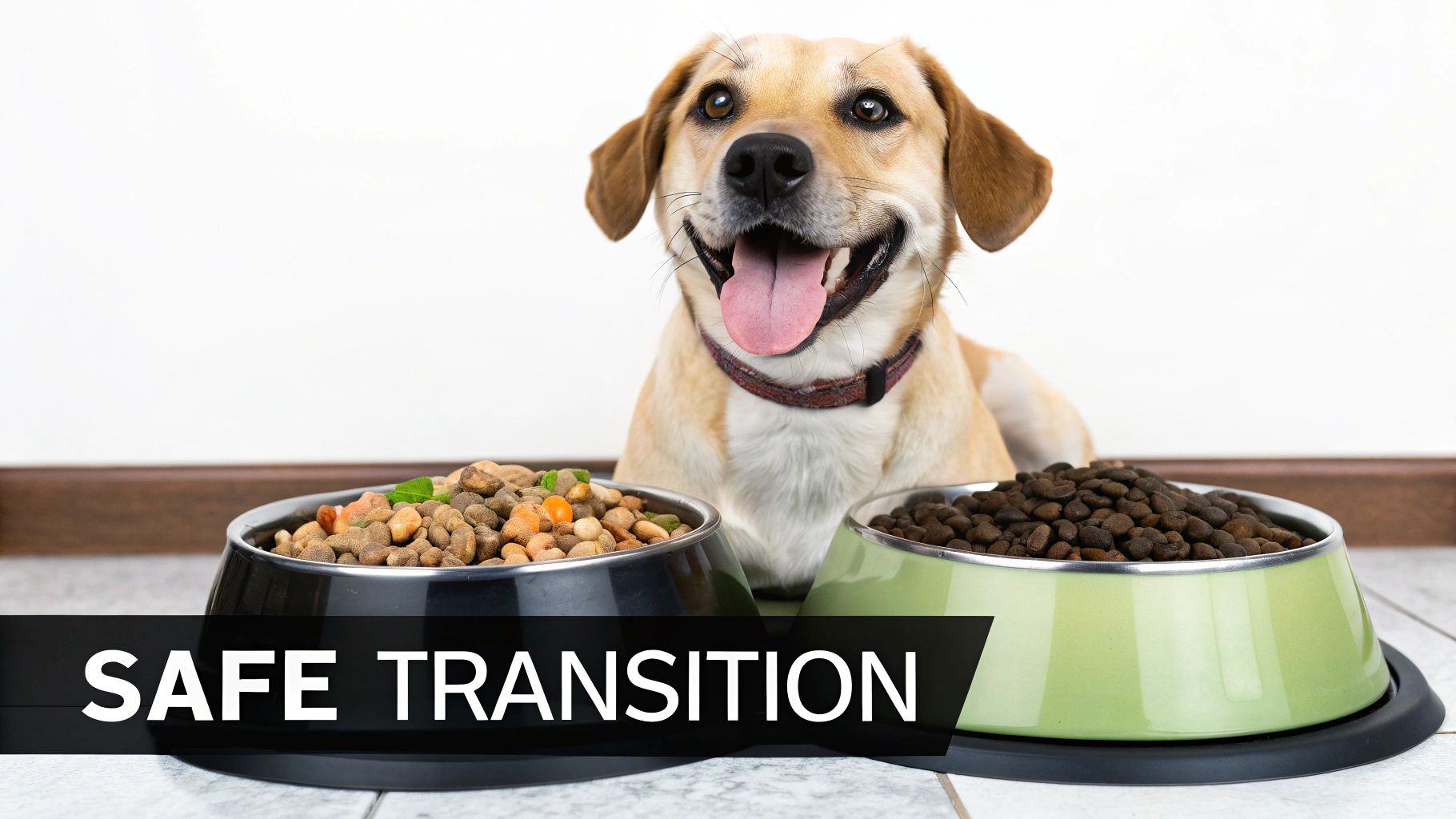
The 7-10 Day Transition Plan
Patience is the name of the game here. The standard recommendation is a 7-10 day transition, which gives most dogs’ systems plenty of time to get on board. If you know your dog is extra sensitive, don't hesitate to stretch this out over 14 days—slower is always better.
Here’s a simple schedule to follow. Just be sure to mix the old and new food together thoroughly at each meal so your pup can't just eat around the new stuff!
- Days 1-2: Mix 75% of their old food with 25% of the new food.
- Days 3-4: Adjust the ratio to 50% old food and 50% new food.
- Days 5-7: Shift to 25% old food and 75% new food.
- Day 8+: You've made it! Time for 100% new food.
This gradual method allows your dog's digestive tract to slowly get acquainted with the different proteins, fibers, and nutrients in the new formula.
How to Monitor the Transition
During this switch, you'll need to channel your inner detective. Paying close attention to your dog's bathroom habits, energy, and appetite is crucial for spotting any issues before they become real problems.
A successful transition isn't about rigidly sticking to a calendar. It's about listening to your dog's body. Seeing a minor setback isn't a failure—it's just a signal to pause at the current ratio for an extra day or two before you continue.
Keep an eye out for these signs.
Positive Signs to Look For
- Firm, well-formed stools: This is the gold standard, the number-one sign that their system is handling the new food well.
- Consistent energy levels: Your dog should be just as happy and playful as ever.
- A healthy appetite: If they're excited for mealtime, that's a fantastic sign they're feeling good.
Red Flags to Watch Out For
- Loose stool or diarrhea: If this happens, don't panic. Just revert to the previous food ratio for another day or two until things firm up.
- Vomiting: This is a more serious sign. It's best to pause the transition completely and give your vet a call.
- Excessive gas or bloating: A little gassiness can be normal with any diet change, but a major increase means you should slow down the transition.
- Loss of appetite: Never force a dog to eat if they're refusing. Take it as a cue to go back a step in the transition plan.
Knowing When to Call Your Veterinarian
Switching to the right food for a sensitive stomach can be a game-changer for your dog, but it's not a silver bullet for every health problem. It’s absolutely vital to understand the difference between a minor dietary hiccup and the warning signs of a serious medical condition.
Think of it this way: a carefully chosen diet is your first line of defense, but your veterinarian is your commander-in-chief. Sometimes, stubborn digestive issues have less to do with the food itself and more to do with underlying conditions like Inflammatory Bowel Disease (IBD), pancreatitis, or even severe allergies that need a professional diagnosis. Being a great dog owner means knowing when it’s time to call in the experts.
This level of awareness is catching on, and it's fueling huge growth in specialized pet food. The global market for digestive health dog food has ballooned to around $5 billion and is growing by 7% every year. This boom is driven by owners just like you who are becoming more savvy about gut health and actively seeking solutions for issues like IBD and food allergies. You can see more on how pet owner awareness is shaping the market on datainsightsmarket.com.
Red Flag Symptoms That Warrant a Vet Call
If you spot any of the following signs, it's time to stop experimenting with food and get your vet on the phone. These symptoms could mean something more serious is at play.
- Persistent Vomiting or Diarrhea: A one-off incident isn't usually a crisis. But if it continues for more than 24 hours or keeps happening, it's a clear signal to call the vet.
- Significant Weight Loss: If your dog is dropping pounds without being on a diet, it’s a major red flag that could point to poor nutrient absorption or a deeper health problem.
- Blood in Stool or Vomit: This is never normal. Whether the blood is bright red or looks dark and tarry, it calls for immediate veterinary attention.
- Extreme Lethargy or Weakness: Is your dog suddenly exhausted, weak, or unresponsive? Don't wait. This could indicate severe dehydration or another urgent medical issue.
- Abdominal Pain or Bloating: A hard, swollen belly or yelping when you touch their stomach is a potential medical emergency. Get help right away.
Never underestimate your own intuition. If you have a gut feeling that something is truly wrong with your dog, even if you can’t quite put your finger on it, trust that instinct and call your vet.
In the end, you are your dog's most important advocate. By learning to recognize these red flags, you can act fast and get your best friend the professional care they need, right when they need it.
At Joyfull, we're committed to clean, high-quality nutrition that supports your pet’s total wellness. Our recipes, developed with our in-house veterinary advisor, are crafted to be both incredibly tasty and genuinely healthy—because a healthful life isn’t just for humans. Discover the Joyfull difference today.
